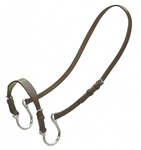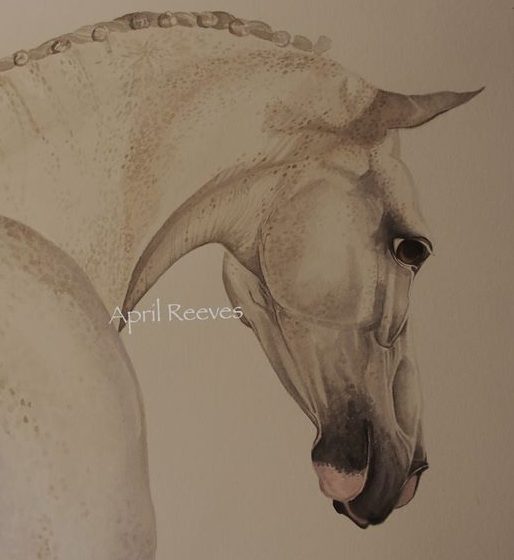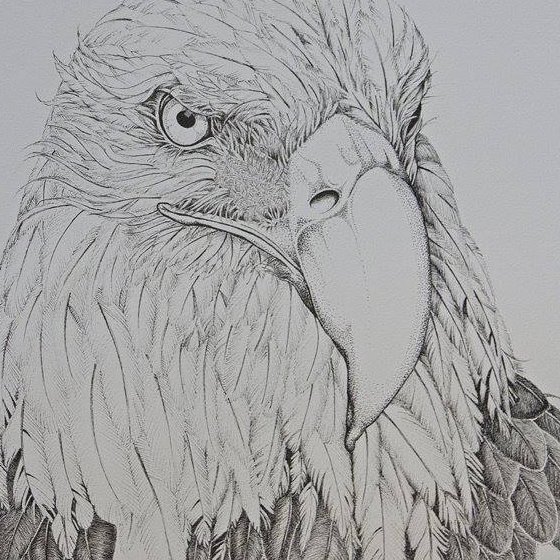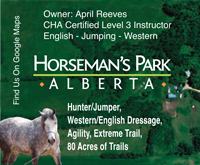 Question: My coach and I have been working on retraining my horse (an Oldenburg/TB cross), for the most part he’s been coming along nicely, but he really LOVES jumping and has the tendency to take the easy out and surge to jumps and fall on the forehand afterward and is hard to pull up. I’m hesitant to go to a harsher bit as I’d rather use mild means and go only as fast in his training than he is ready. We have him in a french-link eggbutt snaffle. Some have suggested a pelham, but I while was browsing the world of bits and equipment I found something called a Kineton noseband. I’ve read so many varied opinions on this piece of equipment that I’m left wondering what to believe. Is this piece of equipment harsh when used properly? (I know that anything including a snaffle can be harsh if used incorrectly). I’m wondering if this type of noseband could be a mild addition to my corrections when he goes to surge onto his forehand and pull?
Question: My coach and I have been working on retraining my horse (an Oldenburg/TB cross), for the most part he’s been coming along nicely, but he really LOVES jumping and has the tendency to take the easy out and surge to jumps and fall on the forehand afterward and is hard to pull up. I’m hesitant to go to a harsher bit as I’d rather use mild means and go only as fast in his training than he is ready. We have him in a french-link eggbutt snaffle. Some have suggested a pelham, but I while was browsing the world of bits and equipment I found something called a Kineton noseband. I’ve read so many varied opinions on this piece of equipment that I’m left wondering what to believe. Is this piece of equipment harsh when used properly? (I know that anything including a snaffle can be harsh if used incorrectly). I’m wondering if this type of noseband could be a mild addition to my corrections when he goes to surge onto his forehand and pull?
Answer from April Reeves: Your problem is common, and one that I see in almost any training level. That being said, it does not need to exist, and will take time to work out. I encourage you to take that time for several reasons: 1. It’s a natural evolution on your path to becoming a better horseman, 2. Taking the time will give you a fresh insight into training methods you will use again with another horse 3. Your horse will be the winner here, as you will not have to resort to harsher equipment.

Read below April's advice for the progress report from the owner!
At the beginning, it’s important to distinguish whether the horse likes to jump, or is jumping to get something over and done with quickly. Since I am not there to watch, I leave it up to you and your trainer to take an objective look at the reasons behind his ‘bold approaches’. There are horses who love to jump, however, they are also willing partners when it comes time to alter their training methods.
I suggest you keep your French-link snaffle. I want to put the responsibility back into your hands, to make this horse ‘correct’ and ‘connect’. Equipment is never an answer for missed training.
So why do horses get into this habit? This is always the question to ask when problems arise. Horses are pretty straightforward. When something is missing or confusing, they let us know. It’s up to us to decipher what that is.
With jumpers, it’s a matter of missed steps in training. Whenever you get into a problem, it is because the foundation, or prior training is missing one or more of the ingredients that help to give confidence to your horse, so that he is capable of handling your request. Simple. I am going to assume he’s telling you that he is lacking confidence, and is taking these fences in this style because it is the only way HE has learned to.
Lets take your horse back a few steps and revisit your flat work. I teach a great deal of dressage with jumpers and hunters as the two go hand in hand. You need to get the horse back to being obedient with the basic foundation: good go and whoa buttons, suppling, softness (but not too soft, as jumpers need a level of ‘weight’ in the hand to be safe and for control) and connection.
Start with the whoa button basics. Take10 days, and spend 5-7 minutes, 3 times each ride, just getting a soft halt from the walk and trot. Start with the walk, and as you ask for the halt, sink in and sit tall. Get him use to that feeling of your change in weight and seat bone placement (it’s also good for your posture). As he gets better, add standards and a ground pole, and walk over the pole and halt 2 steps after. Then move into the trot over the pole and halt, as he gets more obedient.
I know this sounds too simple, but what may appear simple to the human is likely going to be good training for the horse. We as humans need to understand that horses ‘evaluate’ things much differently that we do. What’s small for us is a really big deal to them. This small simple step can change anxiety to confidence.
During these rides, you will also work on suppling. This teaches the horse to relax, plus adding stretching and toning to the muscles. When I watch a rushing, flat jumper, they are always hard on one side and resistant. If you and your coach have a series of suppling exercises, I suggest you spend the time and get him flexible. I do deep lateral stretches with all of my horses, regardless of disciplines. This keeps their bodies in a position to be able to respond with ease to any new movement or question I’m asking – ‘confidence’.
One exercise I’m a stickler for is the hind end disengagement. Using an inside rein behind the withers (never crossing the withers), bring the horse’s head in about 12 inches from your leg/foot. Use your inside leg slightly back, to bend the horse, asking him to step and cross the inside back leg. The moment he responds and you feel that leg coming through, go straight (do not drop him; keep soft contact) and change sides and continue on the other side with the same. Do this over and over until he is responding by following softly (no resistance) and bringing his hind leg under easily. You must feel him cross his inside hind leg over or at least in line with the outside hind. Then continue to do this exercise every time you ride from now on. Remember to keep good forward movement or you will lose the lesson. You can never do too much suppling or balance work. This is different from a leg yield, and it is different from a turn on the forehand.
Why does this help? Many jumpers travel in what I call a ‘box’, where they refuse to put their hind legs under the axis point of the bend. In other words, they will not put their back legs under their belly button. Horses by nature travel in the ‘box’, where their back legs travel at each corner of their body, and by asking them to travel under their belly on a bend means that you have changed the ‘box’ into an inverted ‘V’, which for the horse, means he has to balance or fall over. This takes a long time for a horse to get accustomed to, but it is essential that your horse learn this, as again, it will build up his ability to respond to movements quickly (confidence). Many jumpers that rush or jump flat tend to take their corners with the back legs in a ‘scramble’, where they power into the turn (much like watching a barrel horse) instead of balance and stay in axis through the turn. In fences over 3’ 9” you will get a bit of that, but it should be a matter of choice than lack of training.
I also stand my horses and bring their face around close to my leg, and when they give the tiniest bit in the bridle, I release them instantly. This does 3 things: it gives deep lateral stretching in the tight areas, and it teaches the horse to give and be soft in the face, helping to alleviate the need for harsh equipment.
I also stretch at the walk, working at bending the neck laterally only while moving in a straight line. Your coach can help you with this. Try to get your horse to stretch down long and low also.
These exercises are done every day for the rest of your horse’s life. Try not to overdo your horse’s stiff side. You will get a more versatile flex if you work both sides equally. And remember, if your horse is stiff moving and bending to the right, it’s the left side that is the problem (sore muscles can contract but not extend. If your horse is stiff to the right, it is because the muscles on the left will not extend).
Do lots of circling work on the flat, using your exercise to disengage his hindquarters for a single step, at the walk, trot and canter. Again, this will increase his balance (confidence).
A good set of exercises I use to obtain a degree of ‘collection’ is to skip a gait. This means you move from a walk to a canter, back to a walk and back into a canter again, starting with about 10 strides, until you can do this at 2-3 strides for each gait.
You can also do this as a trot/halt exercise, which for your horse would be very useful.
Why does this work for collection? Horses have successive gaits by nature to allow them to propel their bodies gradually into speed. When you take out the middle gait, you now ask the horse to balance and shorten his frame. This teaches the horse to stay in the position to act upon your aids – obedience.
Another thing I’m a stickler for is obedience in maintaining gaits without any help from the rider. I start the horse on a large circle at the trot with hands to the buckle. I simple request gently to keep the horse in a circle, allowing him to go at any speed he wishes, as long as he stays in the trot. Eventually, the horse will find his comfort spot, where he begins to relax and go long and low, stretching longitudinal muscles (very important for jumpers) and gaining rhythm and cadence. Horses seek comfort by nature, and by allowing him to find it on his own, it gives him the responsibility (confidence) instead of the rider always asking for adjustments. It’s also valuable for pacing fences. Again, I do this at the beginning of every ride, and if the horse is calm right away, I move into other exercises. You cannot do anything without a calm horse. The best of jumpers are calm (don’t confuse calm with bold; a horse can and should have both at the same time).
Now let’s address the surging. Horses need to learn how to ‘sit’ and jump, but normally, if not trained for this, they will acquire the ‘surge’ approach on their own. It’s only normal, since the horse is four-legged and forward, and we are now going to ask him to stand and go up, as a human does. Here’s an exercise to teach him to sit back and use his hocks.
This exercise should only be done once a week, as it can break down the hocks. Set up a gymnastic of 3 jumps; the first one a smaller cross pole (1’6”), then one stride, into another cross pole slightly higher (2’) (not sure what level you train at) to a bounce of a box oxer (a spread, where the two poles are of equal height) at about 2’ high, 1’ wide to start.
Keep the distance normal striding. Do the gymnastic once or twice as long as he is relaxed and soft (if not, lower everything, as height does not matter). Then begin to bring the box oxer in one foot closer, but don’t add any height. Ride that twice or so, and bring the box oxer in again one foot.
Now you will begin to feel a change in your horse’s jump. He has to sit up and use his hocks and haunches in order to propel his body up and over, as opposed to flat and forehand. This is because he has a shorter distance in order to make that work, plus he has a stretch at the top. You are now setting up the exercise to show him that there is another way to use his body over a fence. Couple this with lateral work and all the above exercises, and you are on your way to getting the necessary changes in your horses’ style.
Another lesson you will do, about 2-3 times a week, but for only short times, is the jumping and halting after the fence. Set up a small cross pole to start (1’6”) and ask him to halt softly one to two strides after. (This is a continuation or gradation of the exercise above.) You can raise this fence if it is too low for him (if he is lazy over it). Otherwise, the height is not the lesson here. The stop with obedience is the first lesson. The second lesson is the lightness of forehand. Once you are stopped, pause briefly, move immediately into the trot (as exercises above) and repeat the fence, halting again, pausing briefly and moving into the trot. Continue this until he begins to respond well. You do not have to drill him on this; best to do short intervals 3 times a week, and this is the only additional fence work you will do. It is mixed in with your flat work. As he progresses and becomes light and obedient, move into the canter after the halt, and repeat the fence, halt and repeat.
Now you can take this exercise and slowly expand on it. Use it in front of the box oxer. Set up your short fence, halt, move into the trot or canter, take the above gymnastic entry, one stride, then into the bounce of the third fence and then the box oxer. Then halt again after a few strides. Repeat.
Each step must be built on in succession. When your horse gets into another problem, step back, revisit the foundation, and rebuild. If the horse rushes, go back to flat work and get the balance – confidence. Every ‘glitch’ in the training routine is just your horse’s way of saying “Whoa, I’m not sure I’m ready for this”. Go back – keep it simple.
Other points to consider
Conformation plays a huge role in the horse’s abilities. While many humans think their horse has a future in jumping because it jumped the 4foot gate one day, it is the horse that is put together specifically for the job that has the better chance of being able to endure the rigorous training. Again, I don’t know what your gelding looks like, but you may want to assess whether his flatter jumping style is due to not having all the physical parts line up for the job.
Age is also a factor. If he is much older, and you are fighting a history you don’t know about, it’s a tougher battle. As horses move into double digit ages, they can gather a long list of problems that need to be addressed and worked through first.
When it comes to resistance or tough on one side, pay very close attention to your hands. If you carry one a little higher or wider, and you have more weight in one than the other, this sets up a ‘lesson’ to teach the horse resistance and lack of balance. Stay even and your horse will follow.
 Equipment
Equipment
The Kineton noseband you refer to is a brilliant piece of equipment that I have used. Adjusted properly, they use the nose as a form of resistance along with the bit. This pressure is neither cruel or abusive, as many believe, unless it is adjusted wrong. They should never be adjusted so high that the bit is pulled up in the mouth. They adjust to fit snugly under the bit as it lies properly in the mouth. I see no need for one at this point for you. Should you need one in the future, it would be to work safely over larger fences (over 3’ 9”).
I hope this helps, and if you need any further help feel free to contact me. Good luck and I hope your horse settles in with these exercises. Thank you for your question.
Reply: July 7, 2009
 Hi April
Hi April
I just wanted to forward you some photos from our most recent show. I emailed you back in January about my Oldenburg/TB that was rushing jumps. Since January we went right back to basics, worked on our gaits, worked on our transitions and suppling, worked a lot with poles and reintroduced jumping to him slowly as he built more muscle and balance. We’ve done a few schooling shows this summer to a max of 2’3″ courses and he’s doing fabulously. He’s learnt to set himself up for jumps and to rock back properly. This past weekend we placed 3rd overall (out of 25) in Equitation over fences; 7th and 8th overall in Hunter over fences (out of classes of 20). Some pictures of us attached. We’re still a little baffled by the hanging knee… but some more gymnastic work is definitely in order and we’re going to be trying him in a 2’6″ class in a few weeks to see how he goes there!
 Thanks for your help in January! I appreciated your honest advice!
Thanks for your help in January! I appreciated your honest advice!
Amy












